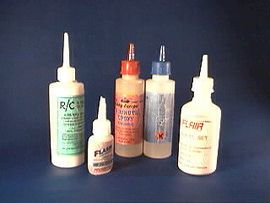

| Tools & Glues To Get You Started |
The most common tools used in
building include a modelling knife such as the  Swan
Morton range of scalpels for lighter work and a Stanley knife for bigger
pieces. Pins (for holding parts over your full-size plans), a small razor
plane, a fine razor saw, small screw drivers, and pliers could be added
to the list. A coping saw and junior hacksaw can also be very useful.
A drill stand with bits in both metric and imperial sizes can come in
very useful. Any tools that can give you an extra 'hand' to grip your
work can be helpful. 'G' clamps of various sizes would come into this
category. A sealing iron will be needed to apply covering to the completed
airframe. Other, more expensive tools such as a Dremel Drill could be
useful but are not absolutely necessary to the newcomer.
Swan
Morton range of scalpels for lighter work and a Stanley knife for bigger
pieces. Pins (for holding parts over your full-size plans), a small razor
plane, a fine razor saw, small screw drivers, and pliers could be added
to the list. A coping saw and junior hacksaw can also be very useful.
A drill stand with bits in both metric and imperial sizes can come in
very useful. Any tools that can give you an extra 'hand' to grip your
work can be helpful. 'G' clamps of various sizes would come into this
category. A sealing iron will be needed to apply covering to the completed
airframe. Other, more expensive tools such as a Dremel Drill could be
useful but are not absolutely necessary to the newcomer.
There are a number of glues on the market and you will need some of these to complete you model. The most commonly used glue is PVA or white woodworkers glue. PVA is relatively slow setting but some brands come with a 'Fast Grab' that locks the wood together while the rest sets over a few hours. Spillage can also be mopped up with a damp cloth. The other most popular glue is cyanoacrylate sometimes known as 'Super Glue' or 'Cyno'. These are now specially formulated for different setting speeds and working with wood of varying thickness.
The thin cyano is the fastest bonding (usually 3 to 5 seconds!) and is best suited to balsa wood where the joint is a good fit and has a solid contact surface. The parts should be joined first and then the thin cyano applied to the joint. The glue will penetrate into the joint and form a solid bond.
 The
thicker or "gap-filling" cyano is useful for general purpose
building where balsa, spruce or lite plywood is involved. Apply the adhesive
to the parts and then join. Drying time is in the order of 5 to 10 seconds.
The
thicker or "gap-filling" cyano is useful for general purpose
building where balsa, spruce or lite plywood is involved. Apply the adhesive
to the parts and then join. Drying time is in the order of 5 to 10 seconds.
The thickest cyano, called "slow-setting" can be used like the "gap-filling" cyano where slightly longer cure times might needed. Drying is around 30 seconds to 1 minute. Although personally we would use PVA for this type of application All of these cyanoacrylates may be cured more quickly with the aid of an accelerator or "kicker" which is sprayed onto the joint after gluing.
Another family of glues that have become very popular is Epoxy. This is a two part adhesive which is mixed and then applied to the surface to be bonded. Epoxy is useful when working with foam as it will not attack the Styrofoam. Epoxies are very strong and many kits manufacturers recommend it specifically for certain parts of the construction. Again Epoxy comes with a variety of setting times from 5 minutes to 24 hours.
Glues all depends on how quick you want to build. As a newcomer to building we would recommend that you build at a slower pace and ensure everything is square and true. Then with experience you can move onto the faster setting adhesives listed above.